Launching a professional looking website can help you represent your business, products and services to the world in the most impressive manner. However, creating a site is not a cup of tea for every business owner. It requires in-depth knowledge regarding the different aspects of web design and web development. You need to learn programming languages and write coding to create fully-fledged websites.
Fortunately, there are dozens of popular content management systems on the web that will help you create an interactive and user-friendly website on the fly. The CMS’s available on the Internet are great platforms that will let you start off your online venture without a hint of worry. They offer plenty of exciting features, functions, tools, plugins and templates to help you develop your first web project.
Despite of having a bunch of content management systems, web designers/web developers/webmasters use only two or three most popular CMSs. Actually, they don’t want to learn other than WordPress, Joomla, and Drupal. They only learn these platforms because they hold a top place in the web market. This means web developers use one or two for all of their websites.
Today, in this blog post, we explore the top 10 Content Management Systems that you can choose for building your first or next user friendly website. Here, we will not only discuss the WordPress, Joomla, and Drupal, but also share other platforms that are more subjective but offer a decent combination of features, user-friendliness, and support.
Top 10 CMSs with their respective advantages:
Must Read
20 Best Code Playground for Your Arsenal
30 Best JavaScript Tools to Speed Up Your Coding
1. WordPress

In the current web development industry, WordPress is considered as one of the well-established content management systems. Although it started its journey as a blogging platform, it has become a fully-fledged web development platform for building different scale and niche of websites.
Today, WordPress powers more than 70 million of websites across the globe. It has become a universal platform for building websites. Most of the business owners, retailers, and other people are using WordPress to craft beautiful website with ease.
WordPress is a PHP based CMS that you can use at a free of cost. It means you can download, install and use at free of cost. It is a user-friendly platform that allows beginners to create and customize a website without even generating a single piece of code. And if you are familiar with coding and programming languages, you can create technically sophisticated websites with ease.
There are millions of remarkable themes and plugins available for WordPress that can help you customize a site the way you want. You can use a responsive, user-friendly, and visually appealing theme to enhance the overall look and feel of a site without any coding. Similarly, you can install a WordPress plugin to extend the functionality of your site. There are plenty of plugins for adding different types of functionalities. WordPress also has an extremely supportive community that makes it easy to find video tutorials and other information regarding WordPress website development. Let’s share some of the key advantages of WordPress:
Advantages:
• Easy-to –use dashboard to help you manage content of a site.
• WordPress offers both free and paid themes and plugins to help you create any type of a site within a few minutes.
• Comprehensive developer community as tons of documentation and tutorials available on the web.
Read More Here
2. Joomla
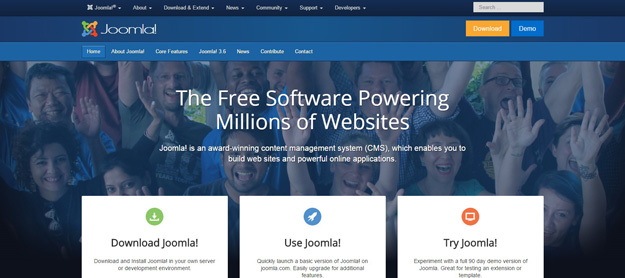
Joomla is a truly an amazing content management system that offers some genuine features that make organizing and managing a site a breeze.
Some of the world’s recognized companies such as MTV, IHOP, and Harvard University has been using Joomla for their websites. It is an ideal platform for back-end networks and is used by Citibank for that particular reason. The platform allows webmasters to create, customize and manage each and every web page of their websites. Plus, there are many trusted Joomla Hosting solutions such as Bluehost, and Hostgator to help you provide 24*7 customer care support.
Since Joomla is the most traditional web development tool, finding tutorials and information related to Joomla is easy. It comes packaged with a plethora of themes, plugins, and add-ons to let you extend the functionality of the site without ever getting your hands dirty in coding.
Advantages:
• Joomla is an open source platform and is available for free.
• It offers over 7000 extensions.
• Easy Migration: If you have a Joomla site, you can migrate to any other server quickly and easily.
Read More Here
3. Drupal

Drupal is the third most popular content management system on the web. It powers millions of websites and web-based applications. It is used by various high-profile companies such as Sony Music, New York Observer, MIT, etc. It is a fully extensible, flexible and scalable platform that allows developers to build a unique and highly interactive website at a breeze.
It is more of a developer-friendly platform, means you need to learn coding and programming languages to create or edit your website from scratch. The CMS offers a ton of stunning features to help you create internal as well as external websites with ease.
Furthermore, Drupal offers a huge and enthusiastic community, along with some IRC channels, forums, and face-to-face Drupal events. The community constantly updates and improves their documentation and tutorials to bring efficiency to their work.
There are over 16,000 modules available for Drupal to help you add extra functions to your Drupal website, without any coding skill. It is a perfect platform for those who want to create a complicated website.
Advantages:
• The community of theme designers has created feature-rich themes to create visually-appealing websites.
• Performance Optimized
• Creates Search engine optimized websites
Read More Here
4. TextPattern
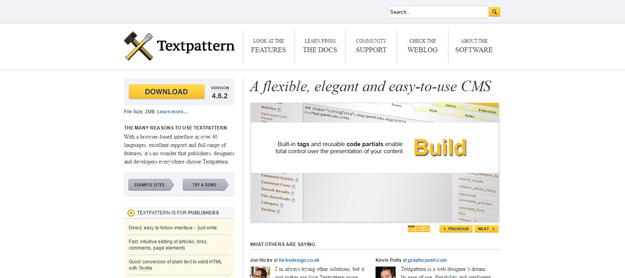
TextPattern is a less popular, but surely a robust content management system on the internet. It is a flexible and scalable CMS that offers various tons of customization settings to the website owners. The platform utilizes a tagging system to make content retrieval, and also uses Textile to convert simple text to well-coded XHTML in your content with ease.
However, TextPattern doesn’t offer a ton of themes or templates to its end users, but still it offers over 120 readymade front-end themes to help you create unique websites. It also offers back-end admin themes to let you improve the user experience for content creators.
To an addition, this CMS offers over 700 plugins and 50+ modules to help you elevate the functionality of the website in minutes. You can use its plugins for adding image galleries, social media integrations, e-commerce, articles, navigation, custom, fields and a lot more.
Advantages:
• User-friendly interface
• A huge community with comprehensive documentation and online tutorials
• Scalable and flexible web development platform.
Read More Here
5. Umbraco
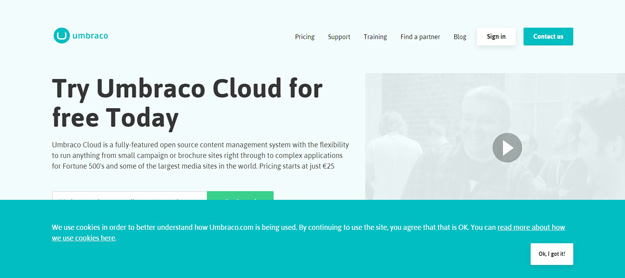
Umbraco is a .net based open source CMS platform that gives web designers a great level of flexibility over their design elements and different approaches. It concentrates on web-standards and offers multiple starter kits and skins to make it quicker to get started. Many reputed websites are using this platform to represent their brand across the web.
The CMS uses a tree-based view that allows you to manage your site’s content with ease. It lets you integrate Flash and Silverlight content at a breeze. It also supports scheduled publishing, previews, and versioning. Another advantage of Umbraco is that it integrates well with content created in Microsoft Word. This makes it easy for users to add, edit and modify the content of their site.
There is an excellent support for web designers and developers to create and customize the back-end of their site using custom applications. It also includes an open API that allows developers to access different aspects of Umbraco that can be viewed via the back-end with ease. It means there are hundreds of custom application options available for web developers.
Advantages:
• It offers free as well as premium support and online tutorials.
• Flexible
• It has an open API.
Read More Here
6. Contao
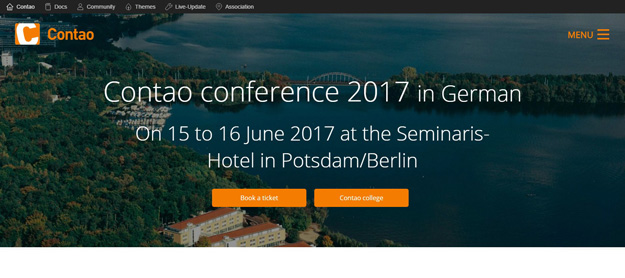
Contao is an accessible content management system, overlooked by many web designers and developers. It includes a user interface that adds Ajax and other Web 2.0 features to enhance the overall usability of a site. There are some advanced editing features for content such as editing multiple records at one or coming back to prior content versions.
It comes with some common inbuilt module, including calendar module that supports different calendars, day-to-day and multi-day events, open-ended events and syndication through Atom or RSS. There some other modules like newsletter module that supports double opt-in emails in either HTML or plain text.
The news/blog module supports multiple categories, featured posts, comments, archives and RSS or Atom syndication. So, you can use the most suitable module and extend your site’s functionality on the fly. Moreover, Cantao offers a few paid themes to help you create a visually appealing website from scratch.
Advantages:
• An extensive range of built-in modules.
• Provides flexibility to design a customized site
• Easy to use for content editors and authors.
Read More Here
7. Concrete5
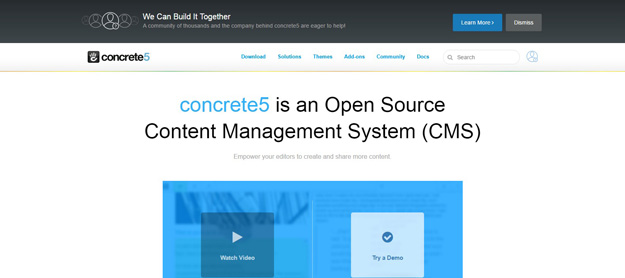
Concrete5 is a powerful content management system that can be used to create full-fledged websites and web applications. It simplifies the process of designing websites as it offers a bunch of beautiful themes that allows you to customize a site without touching a single piece of code. And if you are familiar with coding, you can code your themes with HTML and CSS.
In-context editing is one of the biggest advantages of Concrete5. You can use this feature to replicate the functionality of a word processor while making it easy to edit web pages as you preview them. It is an ideal platform for both the experienced as well as novice users.
Over the last few years, the Concrete 5 has become one of the fastest growing developer’s communities on the web. They have a very active and comprehensive community, add-ons and themes to help you create anything you want to.
Advantages:
• Convert HTML site to a concrete5 one in minutes
• Business-class hosting, along with robust support
• Active developer community.
Read More Here
8. ExpressionEngine
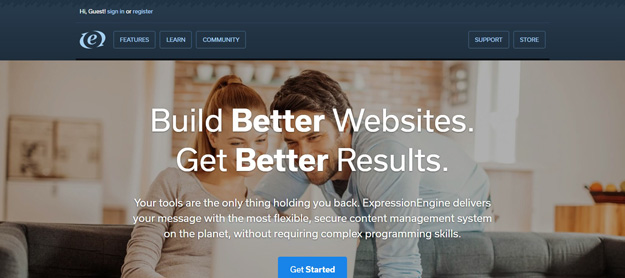
It is a paid content management system, which means you need to buy a license to enjoy its service. We can also say it is a hybrid of commercial and open- source platform that allows users to create and customize a site with ease.
The base code for the ExpressionEngine core is developed on CodeIgniter, their own open-source PHP framework. Plus, there is a talented team of designers, developers, and programmers who are offering technical support to their end users.
You can create beautiful, functional and highly interactive websites using ExpressionEngine. There are few sites developed on it including the Canon Ixus site, LivingSocial Adventures, etc. However, it doesn’t offer too many plugins and add-ons as compared to other CMSs. It only includes 22 add-on modules and over 100 official plugins to let you extend the functionality of your site in minutes.
Advantages:
• Improves the security of the site
• Fully-customizable
• Commercial support
Read More Here
9. SilverStripe
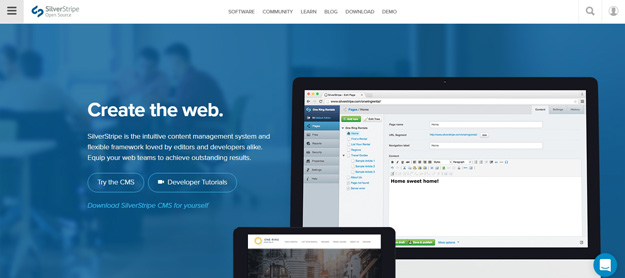
SliverStripe is a simple and intuitive open source platform for building fully-functional websites from scratch. It is the best platform for those developers and designers who are comfortable with advanced coding.
It offers various online tutorials and modules for multiple functions such as blogs, forums, and forms. It also supports multiple page templates to support different requirements.
The platform offers a complete suite of content authoring tools – you can set up your content approval process, publish or unpublish content on particular dates and take different permissions levels for different sections of your site.
Advantages:
• Easy to perform basic functions in back-end
• Built on open standards, so it works well with others
• Customizable.
Read More Here
10. CushyCMS
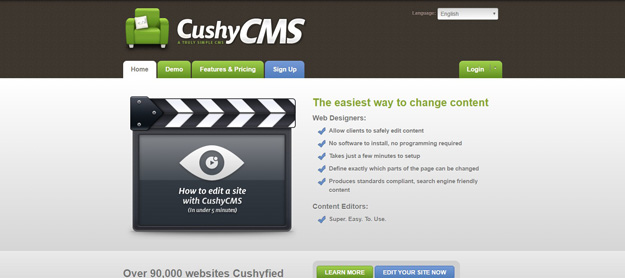
CushyCMS is the only hosted content management system in this blog. Well, there is a limited-feature free version incorporates multiple websites, pages, and editors, but doesn’t allow you to use your own logo or domain name for the admin panel – you don’t customize your admin area. On the other side, the paid version has various advanced features, along with branding support.
The platform allows clients to edit their own content without the assistance of any expert. You can even design your site and then add it to the CushyCMS account, from where you can determine which parts are editable.
CushyCMS is different from other CMSs because it doesn’t offer any plugin or themes. But designers can use their skills to create pre-defined themes for the CushyCMS based websites.
Advantages:
• Easy to edit content
• Easy to get started
• Offers free plans
Read More Here
Conclusion
These are the top 10 content management systems on the web. Regardless of WordPress, Joomla and Drupal, you can look at these seven CMS’s as well. But before making any final decision, make sure that you cross-check your business needs and specific requirements that can uplift the standard of your site.
If you are new into the web development industry or don’t have in-depth coding skills, then you can use WordPress, Joomla, TextPattern, and CushyCMS platforms. Because these offer simple and intuitive user interface that lets you create and customize a site with less or zero coding.
But if you love coding or want to customize the design of your site from scratch, then Drupal, Contao, Concrete5, ExpressionEngine, and SilverStripe are ideal options for you. These CMSes give complete flexibility to web designers and developers to create a site using advanced coding skills.
So, the final decision of choosing the best CMS is completely depends on your potential and your specific requirements.









Leave a Reply